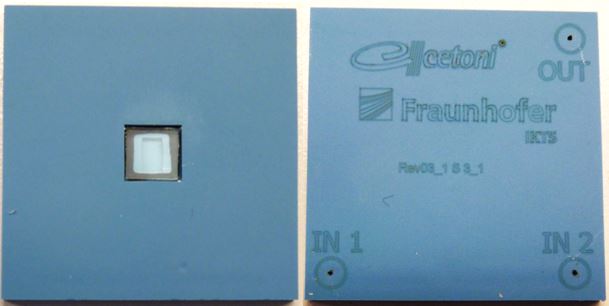


By using modern materials of high-performance ceramics, like Low Temperature Cofired Ceramics (composite material of glass and ceramic) and High Temperature Cofired Ceramics (effectively glass-free ceramics), innovative solutions for microreactors can be created.
With the possibility to fit optical windows in ceramics, photochemical syntheses and online-process-analytics can be realized. Based on the process requirements, the development proceeds in a typical sequence of geometrical layout, optimization by using analytical or numerical modelling, simulation and fabrication of prototypes. The Integration of sensor elements (such as temperature and pressure sensors) and of functional structures for temperature control (such as electric heaters or cooling channels) extends the functionality to a ceramic microreactor.
The reaction, which is proceeding in the ceramic chip, demands for an inlet for the fluid or the gaseous reactants and for an outlet for the reaction products. The ceramic body enables process temperatures up to 900 °C, which demands for high temperature stable packaging technologies (electrical and fluidic contacts).
Indeed, based on the layout of the ceramic chip, the fluidic connections can be thermally uncoupled from the reaction zone, but also high-temperature-resistant bonding techniques (glass or metal soldering, ceramic glues, seal rings) are available. An optimization of the reactor design can follow these criteria:
- choice of the ceramic material in regard to the compatibility with the fluid,
- designing the reactor for specific internal pressures,
- reduction of pressure loss in the flowfield,
- monolithic integration of mixer structures and reaction channels and
- Integration of sensor components such as pressure and temperature sensors, plus active temperature control through embedded heaters or coolers.
Technical Characteristics
- microsystem based chip design (planar construction, lateral dimensions up to 100 mm x 100 mm, thickness < 3 mm)
- high-temperature-resistant ceramic chip material (300°C/600°C and higher)
- internal geometrical patterning (channels for generating mixer ranges < 100x100 µm2, reaction chambers, pressure loss < 0,4 bar)
- internal channels adequate to non-stick-conditions for nanoparticles
- temperature-resistant and thermal uncoupled fluidic leads
- integrated detection windows (borosilicate glass)
Services Offered
- Development of ceramic reactors for microreaction technologies
- Elaboration out the production process
- Manufacturing of prototypes and samples
- Technology transfer